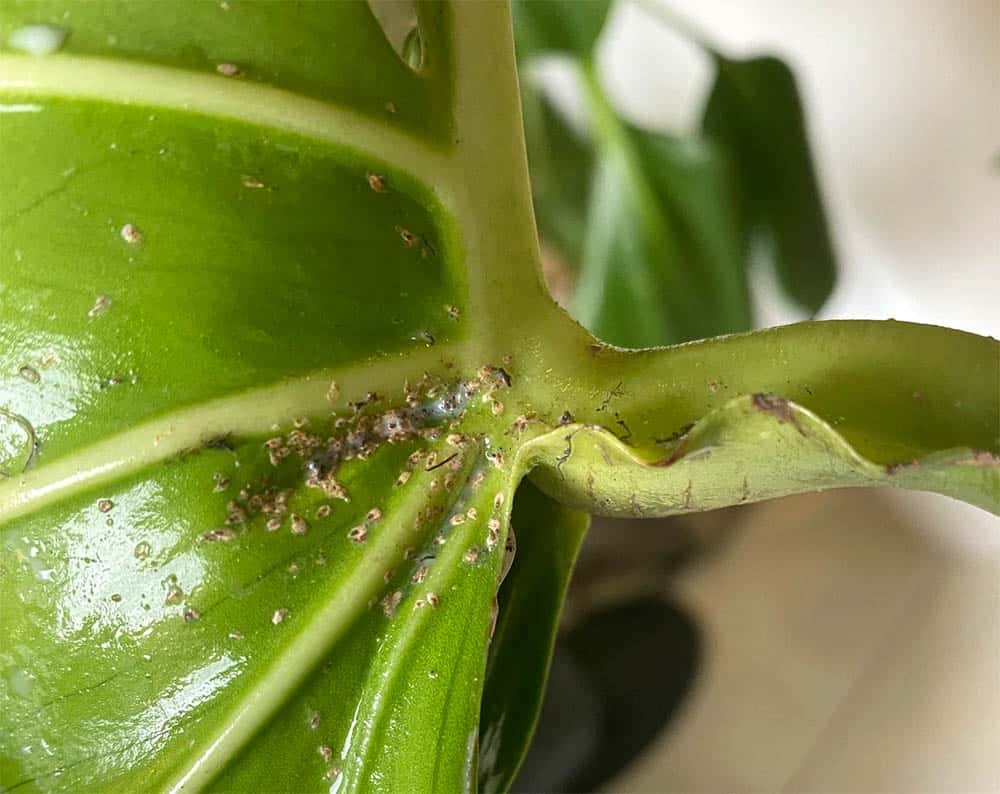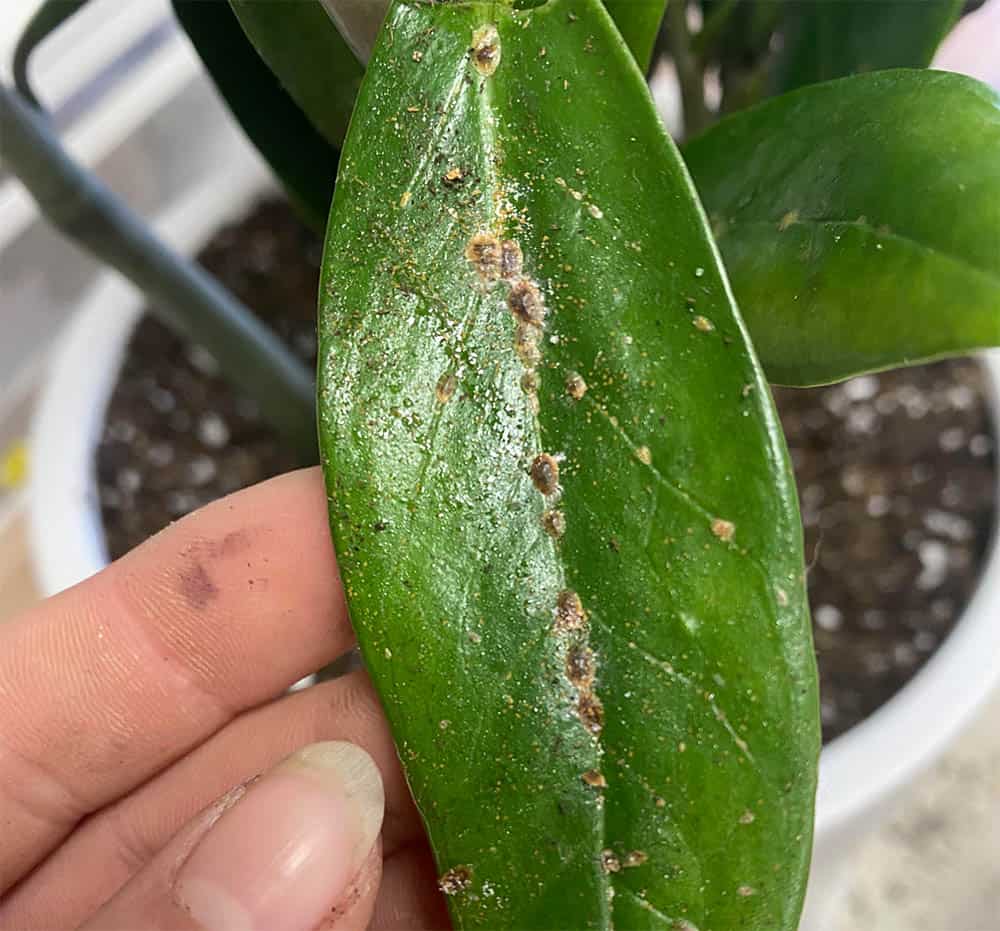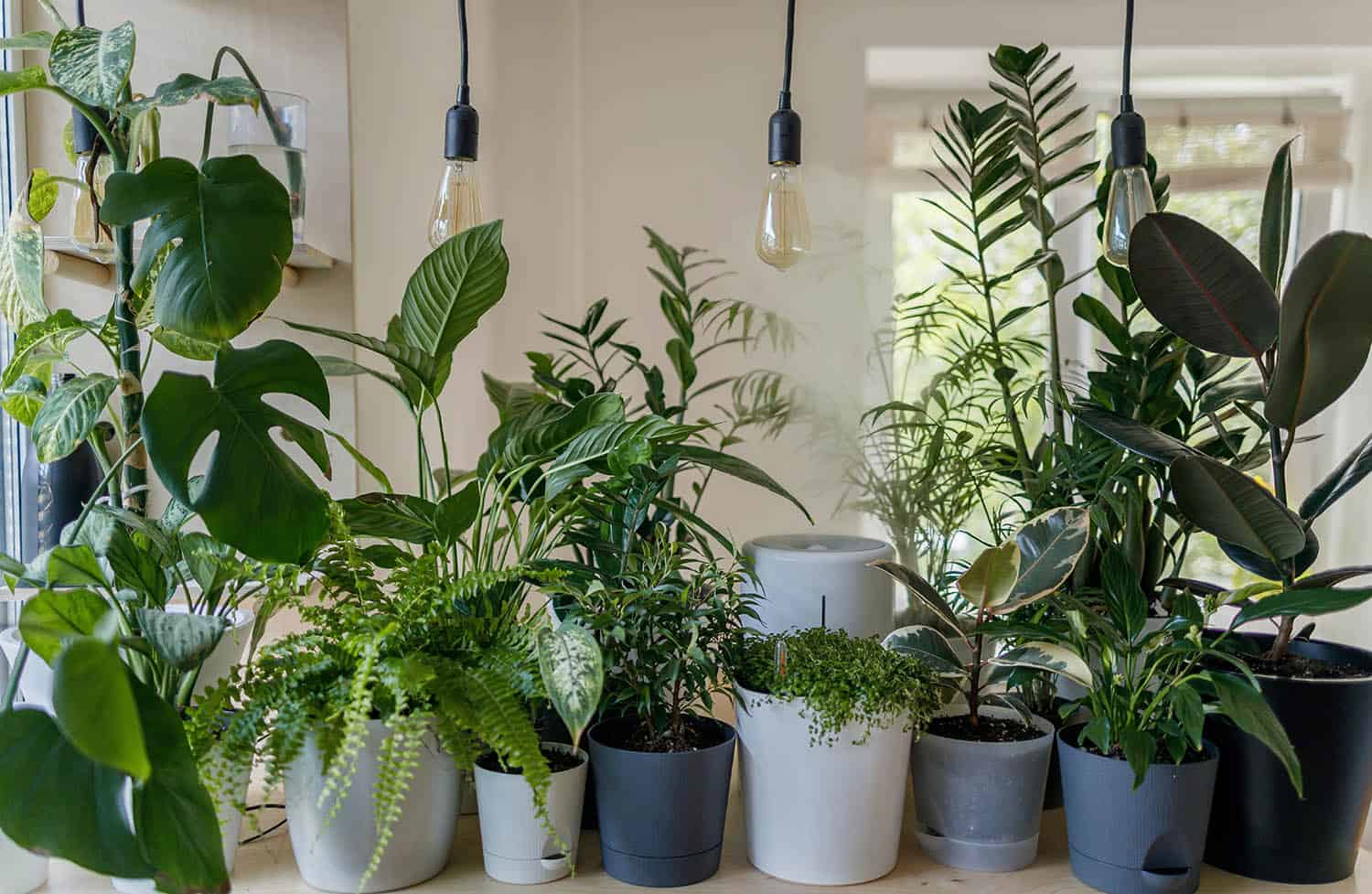Although more commonly found outdoors, scale insects can be particularly persistent pests once they make their way onto an indoor houseplant. Because of their strange bodies and protective covers, many people aren’t sure what to make of them. How do they move and spread? How should you treat for them? And what kind of damage are they causing?
Scale are small, sap-sucking insects that attach and feed on a plant with their mouthparts before forming a waxy, protective coating that keeps them in place. Although fairly sedentary pests, scale insects spend their time as a juvenile crawling around in search of a new feeding spot on a plant.
Although not the most mobile of plant pests, scale insects do a fairly good job of growing their population and spreading from plant to plant. Knowing how they move and spread, as well as how they reproduce, how they feed, and the kind of damage they inflict on plants, will help you recognize an infestation early on.
This will give you the upper hand when it comes to applying the right treatment options to eradicate these pests from your home.
In this article, we’ll cover the most common questions people have about scale insects. This will give you a better understanding of pests, so you will be prepared to fight them off if they ever show up in your home.
What Are Scale Insects?
“Scale”, “scales”, or “scale insects” are all umbrella terms that describe a large, diverse group of sap-sucking insects that are most readily identified by a tough, waxy coating that protects their soft bodies. These coatings often resemble a single scale of a fish or reptile, hence their common name.

Scale insects are closely related to other sap-suckers, including aphids and whiteflies. In fact, mealybugs are technically included in the scale family, but because they are fairly unique, they tend to be discussed separately. If you want to learn about mealybugs specifically, you can read more about them in this article.
All scale insects are identifiable by their protective covering, which they develop at their adult stage of life. These coatings can come in many shapes and colors, and most species have unique enough coverings that they are often identified by this attribute alone.

When discussing scale on indoor houseplants, more often than not, you are dealing with a soft scale variety, with bodies only reaching sizes of about 1/8”. Their wax coatings usually start pale and darken with age, often resembling a tortoise shell pattern, although they can be many different colors. There is another class of scale called armored scale, but the varieties in this category are more commonly found outdoors.
Female adult scales tend to be mostly immobile. Although some retain their six legs, they typically stay put once they find a feeding spot and begin to produce their coating, which effectively fuses them to the plant tissue.
Male scale insects are tiny, fly-like bugs that are rarely seen. They are too small to travel far and lack the ability to feed on plants, so their only real job is to go in search of a female to mate with before they die.
How Do Houseplants Get Scale?
Like many other houseplant pests, scale insects are most often introduced to new houseplants through transference. Being largely immobile, it seems unlikely that scale would easily spread from plant to plant, but because of their juvenile “crawler” stage, passing scale from one plant to another is actually a fairly simple affair.
Scale is much more prolific outdoors, but because the juveniles are so tiny, they can easily catch a ride into our homes on our clothing, our pets’ coats, or even by getting caught by a strong gust of wind.
Most commonly, houseplants get scale from us bringing new plants into our homes. Although growers and plant shops work hard to keep plants pest-free, scale insects are small and can easily be missed during an inspection.
If even a few fertile females or juvenile crawlers are introduced to our homes, they can start and establish a growing population within a matter of weeks. This is a good reminder that any new plants you bring into your home should be isolated for several days before being incorporated into your larger plant collection.
What Does Scale Damage Look Like?
Because of their tiny size and sedentary lifestyle, scale insects tend not to inflict a whole lot of damage to a plant until their numbers start really growing. In fact, you may even miss the fact that you have a scale infestation in your home until your plant starts to exhibit signs of distress.
Scales are sap-sucking insects and feed by tapping their mouthparts into the tissue of the plant to access the phloem. The phloem is part of a plant’s circulatory system, so to speak, and is responsible for moving the sugar-rich sap throughout the plant.
Damage from feeding is minimal at low levels but can eventually become pretty significant as the population begins to explode. Feeding damage results in leaf yellowing and distorted growth. More advanced infestations can cause the plant to suffer from chlorotic leaf tissue, plant wilt or droop, leaf drop, and stunted growth.
Scale also produces honeydew, which is a sticky excretion left behind. It tends to coat plant surfaces and promotes the growth of sooty mold, a fungal infection that causes a plethora of issues.
Will Scale Insects Kill Houseplants?
As was mentioned above, damage from an individual scale insect is rather minimal. However, if left untreated, a population can get so out of control that the compounded damage begins to put the plant at severe health risks.
If your plant is exhibiting signs of leaf drop, wilt, droop, or deformed or stunted growth, you can be sure it is under extreme duress. Left in this state for too long, your plant’s health can easily crash and result in death.
If you want your plant to thrive, treatments must be applied to the plant to kill back the scale populations.
What Is the Scale Lifecycle?
Scale insects tend to have a three-part lifecycle, all of which happen within the plant foliage. Adult females will lay eggs under the protective coating covering their bodies. It can be anywhere from 50-2000 eggs depending on the species. Within a matter of one to three weeks, those eggs can be ready to hatch.
Again, depending on the species, these eggs will hatch (or the adult female with give birth to live young), and the juvenile “crawlers” will emerge. “Crawlers” is the informal name given to the first juvenile stage of scale insects which use their legs to crawl in search of a new spot on the plant to feed.
Once they find their spot, these crawlers will morph through up to three additional juvenile stages, with only a few species retaining their ability to crawl after that first stage. These new adults will insert their mouthparts to start feeding and then begin to produce the waxy protective coating, keeping them safe from predators and harsh environmental conditions.
Soft scale varieties tend to only have about one lifecycle per year, although this depends on the specific conditions of your home. Armored scales can carry out several lifecycles over the course of a season.
Can Scale Insects Fly?
Female scales, which are pretty much all you’ll ever see on your houseplant foliage, are relatively immobile. Although some species retain their legs as adults, they rarely use them once they’ve found their feeding spot and begun to produce their waxy coatings.
Male scale insects can fly. As mentioned above, these tiny, gnat-like bugs fly around in search of females to mate with. They lack the ability to feed on plants and can’t start a new population on their own, so their only real purpose is to reproduce.
How Does Scale Move? Can Scale Crawl?
Scale insects are known to be largely immobile, mainly because we only really take notice of their adult stage, where most scale species have already lost their legs and ability to crawl.
However, scales all go through the juvenile “crawler” stage, nicknamed such, because these nymphs have sets of six legs that give them the ability to crawl over the surface of a plant.
This crawler stage is when the young scales will find new spots to feed on the plant or if resources are scarce, go out in search of a new host plant. Because of their tiny size, it helps when other plants are closely clustered together, making it easier to crawl from pot to pot or across overlapping foliage.
Once they are settled in a suitable spot, many scale species will morph through various stages, eventually losing their legs as they become adults.
Will Scale Spread to Other Plants?
As a scale population grows on a houseplant, the number of mobile crawlers that hatch from each turn of the lifecycle also grows exponentially. If given the opportunity, either through proximity or by the help of our shirt sleeves, these crawlers will eventually find their way onto other houseplants.
Most commonly, scale spreads from plant to plant if they are bunched together, with foliage from each plant overlapping each other. This makes a very easy bridge from one plant to the other that juvenile scale insects are all too willing to crawl across.
We can easily transfer tiny scale nymphs from one plant to the other on our clothing. Even with something as simple and essential as watering our houseplants, we may inadvertently be acting as the vector for these insects to spread from plant to plant.
In rarer instances, juvenile crawlers can make the incredible journey from one potted plant to another. They can survive a few days without feeding, so they are equipped to make the daunting crossing between houseplants, although it’s much more common that they’ll stay put on a plant as long as there are enough resources available.
What Houseplants Attract Scale?
In general, soft scale varieties, which are commonly found indoors, prefer attacking tropical and sub-tropical plant species. Unfortunately, this means that most of our beloved houseplants are at risk, especially the ones that can provide the insects with easy access to the phloem sap they feed on.
Although commonly attacked outdoors by armored scale species, woodier plants and shrubs that live indoors are a bit more protected.
Can Scale Live on Furniture?
Because scale insects require a plant for both sustenance and to complete their lifecycle, they don’t survive long without one. As mentioned above, they have the ability to survive a few days on their own but will quickly perish without a host plant.
That being said, you don’t have to worry about a scale population building up between your sofa cushions. Any individual insects that might find themselves on your furniture will die within a matter of days unless returned to a plant.
Are Scale Insects Harmful to Humans?
Scale insects are no threat to humans. While they have impressive mouthpart structures to pierce through plant tissues, they are far too small and delicate to break through our skin and, therefore, can’t bite us.
Why Does Scale Secrete Honeydew?
Plant sap is very sugary and, therefore, fairly carbohydrate heavy. For the scale to get enough of all the nutrients they need, like protein, they need to be able to consume a lot of sap while being able to bypass the sugary carbohydrates that are in abundance.
Additionally, phloem is somewhat pressurized in order to carry nutrients all throughout the plant. When scale insects insert their mouthparts into the plant tissue to access the phloem, that pressure pushes a lot of sap through that opening, and their body, rather quickly.
In order to handle these issues, scale have adapted to secrete honeydew, which is basically just hardly processed sap being pushed through the insect’s digestive system. As the scale continues to feed, more and more of the honeydew builds up around the feeding site and tends to coat plant surfaces with this sticky substance, which can promote mold growth and disrupt photosynthesis.
How Do You Treat for Scale?
Once scale is discovered on one of your houseplants, it is best to act quickly in order to keep the population in check and prevent them from spreading to other plants in your home.
First, you will save yourself some headaches if you isolate your infested plant away from the rest of your collection. Do not give scale the chance to spread. Also, be mindful about washing up after handling a scale-infested plant. You don’t want to be the cause of the spread by allowing crawlers a free ride on your shirt sleeves.
Because of their lifecycle, your best bet is to deploy treatment methods that attack both the adults and the juvenile crawlers. It’ll help if you can actually monitor your plant for signs of crawlers so you know when a treatment application would be most effective.
Do this by inspecting your plant with a magnifying glass daily until you see tiny crawling insects. You can also secure double-sided tape to parts of the plant and check to see if you catch any crawlers each day. Once they are active, some kind of spray should be used to fully coat the plant that targets these crawlers.
For adults, physical removal or spot treatments are very effective methods of control. Removal of the adults reduces the number of viable egg layers and exposes already laid eggs that would otherwise be protected under a waxy covering.
Short of peeling adults off of the plant, you can also apply soapy water or rubbing alcohol to individual scale to dissolve their coverings and expose them to desiccation or suffocation.
After adults have been treated, continue monitoring for any signs of crawlers and then apply insecticidal soaps, Neem or horticultural oils, or chemical insecticides to kill off juveniles before they can form into new, egg-laying adults.
Regardless of the stage you are targeting, good coverage is the key to any treatment being effective. Scale insects are tricky and like to wedge themselves between stems and leaf petioles, within thick foliage, or in other hard to reach places.
Strategic and thorough applications of spot treatment, sprays, or oils will help reduce the number of times you might need to repeat a specific treatment method.
If you are interested in learning more about treatment options for both adult and juvenile scale, take a look at our in-depth guide.
Final Thoughts
Scale insects are strange but common pests that can find their way into our homes and infest our plants. Although they can be persistent, options are available to get rid of them. By better understanding how scale insects live, reproduce, and spread, you should be better equipped to recognize the damage they cause early so you have the best chance at eradicating an infestation quickly.
Remember to be thoughtful and thorough when treating for scale, and know that you’ll likely have to repeat applications several times before you can be sure your plants are scale-free. Be persistent and monitor things closely; you’ll have a fully recovered houseplant in no time.















